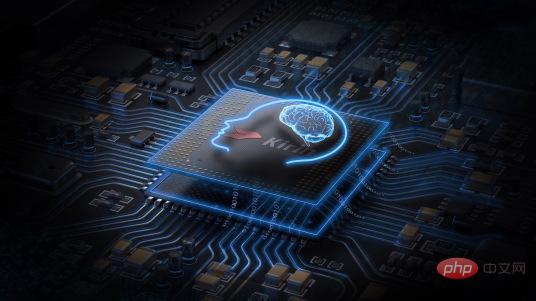Home >Common Problem >Kirin 970 is made using a process of several nanometers
Kirin 970 is made using a process of several nanometers
- 青灯夜游Original
- 2022-12-06 14:28:195351browse
Kirin 970 is a 10nm process. The Kirin 970 chip is a new generation chip launched by Huawei HiSilicon using TSMC's 10nm process. It integrates 5.5 billion transistors and reduces power consumption by 20%. Kirin 970 integrates NPU for the first time and adopts HiAI mobile computing architecture. Its AI performance density is significantly better than that of CPU and GPU. Compared with four Cortex-A73 cores, Kirin 970’s new heterogeneous computing architecture can handle the same AI application tasks. It has approximately 50 times energy efficiency and 25 times performance advantages.

The operating environment of this tutorial: EMUI 13 system, HUAWEI nova 4 mobile phone.
The Kirin 970 chip is a new generation chip launched by Huawei HiSilicon using TSMC's 10nm process. It is the world's first smartphone AI computing platform with a built-in independent NPU (neural network unit).
Huawei calls Kirin 970 "the first artificial intelligence (AI) mobile computing platform" to highlight Huawei's leadership in the AI field.
The Kirin 970 chip is based on TSMC’s 10nm process. Kirin 970 also integrates an unprecedented number of 5.5 billion transistors, reducing power consumption by 20%. With the forward-looking NPU dedicated hardware processing unit, the AI performance density of Kirin 970 is significantly better than that of CPU and GPU. The heterogeneous computing architecture brings about 25 times the performance and 50 times the efficiency.

Function and Features
-
Specialized AI hardware processing unit
The biggest feature of the Kirin 970 chip is that it has a dedicated AI hardware processing unit—NPU (Neural Network Processing Unit), which is used to process massive amounts of AI data.
-
Artificial Intelligence Strategy
After the release of Kirin 970, Huawei’s terminal marketing should use “AI” as a prominent selling point and start building around AI ecology. In the era of artificial intelligence, the ideal situation is that smart terminals will become human assistants, truly "knowing you", "understanding you" and "helping you". This requires the continuous evolution of artificial intelligence technology, which not only passively responds to user needs, but also actively perceives the user's status and surrounding environment, and provides new interactive methods with precise services.
Explanation
In the past, mobile phone chips were generally based on CPU (Central Processing Unit)/GPU ( Graphics processor)/DSP (digital signal processing) is the core of the traditional computing architecture, but this architecture is difficult to support AI massive data calculations. To this end, Kirin 970 has a dedicated AI hardware processing unit in the mid-mounted unit to reduce the load on the CPU, GPU and other architectures, all with the purpose of improving application efficiency and reducing energy consumption.
This is the same as the original intention of adding DSP and other architecture designs in addition to CPU and GPU, which is to share the computing burden of the main system.
Huawei Kirin 970 integrates NPU for the first time and adopts HiAI mobile computing architecture, whose AI performance density is significantly better than that of CPU and GPU. Compared with four Cortex-A73 cores, Kirin 970's new heterogeneous computing architecture has approximately 50 times energy efficiency and 25 times performance advantages when processing the same AI application tasks. This means that the Kirin 970 chip can complete AI computing tasks with a higher energy efficiency ratio. For example, the image recognition speed can reach about 2,000 images/minute.
Kirin 970 innovatively designs the HiAI mobile computing architecture, using the most energy-efficient heterogeneous computing architecture to maximize the performance of CPU/GPU/ISP/DSP/NPU. At the same time, it integrates NPU dedicated hardware processing units for the first time, which accelerates The performance and energy efficiency ratio are significantly better than those of CPU and GPU.
A system-level mobile phone chip mainly includes CPU/GPU/DSP/ISP, baseband chip and many other components. This time the Kirin 970 still has a built-in eight-core CPU, which is unchanged from the previous generation Kirin 960. In terms of GPU, Kirin 970 uses the Mali-G72 architecture just released by ARM in May 2017. Its performance is improved compared to Mali-G71. In addition, in terms of core number, Kirin 970’s GPU has also changed from 8 of Kirin 960. The number of cores has been increased to 12 cores.
In terms of baseband chips, Huawei has given full play to its advantages as a communications equipment manufacturer. Kirin 970 directly supports LTE (4G) Cat.18 (network speed level), and the maximum download speed can reach 1.2Gbps.
Although there are no big surprises in the CPU and GPU, the overall performance will be improved because the Kirin 970 uses a 10-nanometer process. Yu Chengdong said that the energy consumption ratio of Kirin 970 has increased by 20%.
For more related knowledge, please visit the FAQ column!
The above is the detailed content of Kirin 970 is made using a process of several nanometers. For more information, please follow other related articles on the PHP Chinese website!

